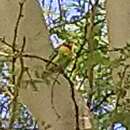Biology
(
英語
)
由Arkive提供
The need to drink water at least twice a day is a critical determinant of the daily and seasonal activities of the black-cheeked lovebird (6). In the non-breeding season, this species congregates in large flocks of up to 800 birds, reaching maximum numbers in the early mornings and late afternoons, when the birds drink and feed. It feeds mainly on the seeds of annual grasses and herbs, including crops such as millet and sorghum, but will also forage for a wide range of other items such as leaves, nectar, fruit pulp, invertebrates, bark, lichen and soil.
Natural cavities in live mopane trees are utilised for roosting and breeding. The breeding season extends from mid January to early May, and corresponds with annual maximum rainfall and the beginning of the dry season. Each pair probably uses the same nest site year after year, and produces a single clutch of six to seven eggs (2) (6).
Conservation
(
英語
)
由Arkive提供
While evidence suggests that the demand for wild caught black-cheeked lovebirds is very low, it remains important that a ban, instituted in the 1930s, in the trade of wild caught birds continues to be enforced. The current primary objective of black-cheeked lovebird conservation is to reduce disturbance at existing water sources and to create additional permanent drinking sites. It is hoped that this will encourage the species to return to areas within its former range. A further priority of conservationists is to continue interacting with farming communities, particularly in schools, to promote lovebird conservation amongst local people. In the long-term, it is also imperative that the black-cheeked lovebird population is monitored on a regular basis to inform future conservation measures (2) (6).
Description
(
英語
)
由Arkive提供
The lovebirds comprise nine species of small but solidly built parrots, renowned for their strong pair bonds (4). The black-cheeked lovebird is bright green except for a dark brown head, olive nape, bold white eye-ring, red bill and an orange patch on the chest. The juvenile is similar in appearance to the adult bird, but its bill is grey or orange. In common with the screeching chatter of other lovebirds, this species has a loud, shrill call (2) (5).
Habitat
(
英語
)
由Arkive提供
This lovebird occurs in deciduous, mopane (Colophospermum mopane) woodlands, where there are permanent supplies of water (2).
Range
(
英語
)
由Arkive提供
The black-cheeked lovebird occurs patchily in south-west Zambia, with two sub-populations distinguishable during the dry season in the catchments of the Zambezi and Kafue rivers (2) (6). Unconfirmed records of this species also exist from Botswana, Zimbabwe and Caprivi region of Namibia (2).
Status
(
英語
)
由Arkive提供
Classified as Vulnerable (VU) on the IUCN Red List (1) and listed on Appendix II of CITES (3).
Threats
(
英語
)
由Arkive提供
Between the 1920s and the 1960s, the black-cheeked lovebird was heavily exploited for the cage-bird trade (2). Fortunately, current trade in live specimens is at a very low-level. However, since the mid-20th century, gradual desiccation within the black cheeked lovebird's range, attributable to a decline in annual rainfall of around five millimetres a year, has significantly narrowed the amount of suitable habitat available to this species. This is further exacerbated by the recent establishment of numerous hand-pumped bore-holes, which under heavy usage reduce the amount of groundwater supplying natural water sources. Consequently, the black-cheeked lovebird, which avoids water actively disturbed by humans or livestock, is increasingly more dependant on artificial sources, such as watering points for cattle (2) (6). This lovebird is also considered by farmers to be a serious agricultural pest, accounting for significant damage to millet and sorghum crops in southern Zambia (2) (6) (7). However, efforts by local farmers to protect their crops are largely ineffective and rarely harmful to the birds (2) (6).

